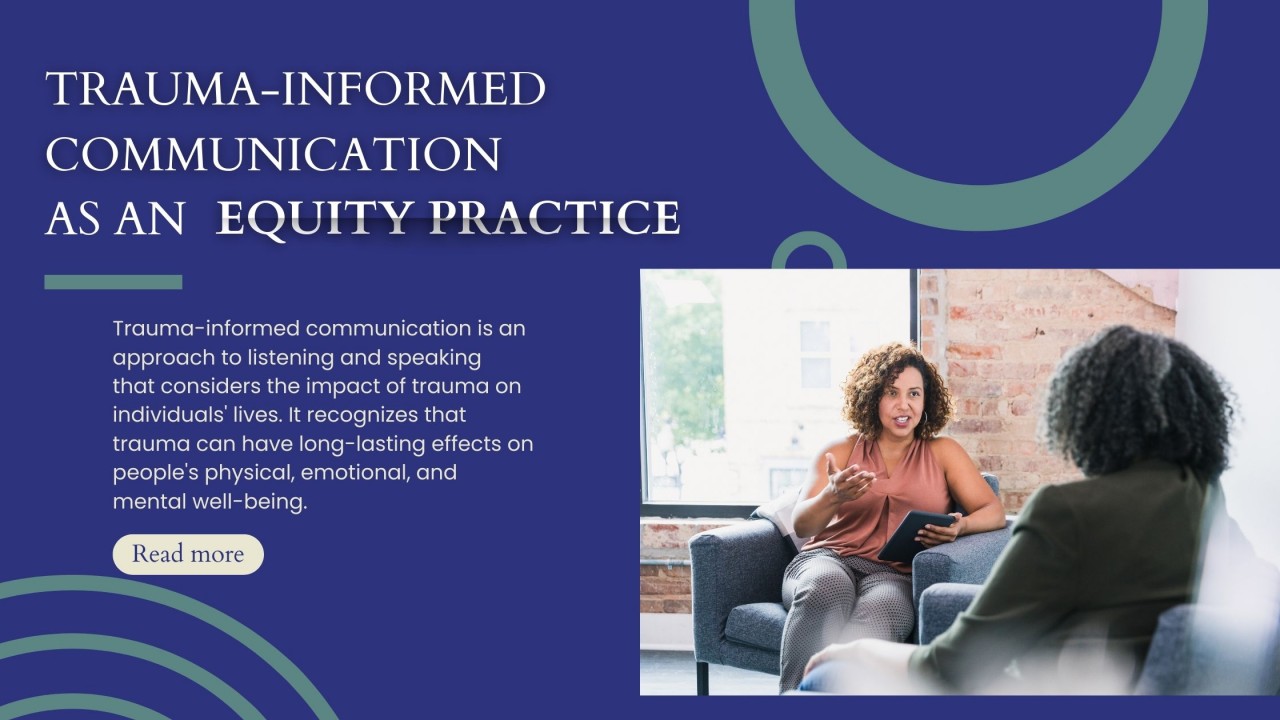(404) 793-0011 | drmaiysha@drmaiysha.com
Trauma-informed Communication as an Equity Practice
In our most recent NLP training, we discussed the importance of being trauma-informed in our communication, and I was asked how the skills they were learning could help them to communicate in a more trauma-informed way, and how this relates to equity and inclusion. To answer that question, let's distinguish the world of trauma and trauma-informed communication and how it impacts and improves equity.
Trauma-informed communication is an approach to listening and speaking that considers the impact of trauma on individuals' lives. It recognizes that trauma can have long-lasting effects on people's physical, emotional, and mental well-being. Being trauma-informed often talked about in terms of clinical approach, however, it is an essential social justice practice that acknowledges the intersection of trauma and equity.
If you look at how trauma impacts equity, you can see that trauma and inequity are inextricably linked. Communities that have been historically marginalized experience higher rates of trauma due to systemic oppression, discrimination, and violence. The impact of trauma on these communities can be devastating, leading to poor health outcomes, mental health disorders, higher risk for cardiovascular disease, and difficulty accessing education and employment opportunities. Trauma can create barriers in communication leading difficulty to accessing healthcare, social services, and justice systems.
When we embark upon the trauma-informed journey, we are committing to a journey of expanding ourselves such that we become, and we create a listening that allows for authentic expression and communication with the people with whom we interact.
This involves four key elements:
Safety: When we are listening and speaking from a trauma-informed lens, we provide a space where the people we are communicating with feel heard and supported. Often times this leads to a feeling of safety and security which creates an opening in conversation rather than a cutting-off action.
Trustworthiness: With safety comes trust, and trust is essential for authentic communication to happen. Being reliable, transparent, and honest in our communication helps to avoid misunderstanding. Additionally, setting boundaries, expectations, and limitations eliminates confusion and keeps everyone on the same page.
Choice: The experience of trauma (past or present) can create an experience of powerlessness in people. The trauma-informed approach to communication prioritizes giving people choices. When we increase choice with the people in our lives, we give them agency, autonomy, and a sense of control in their expression. While some may feel that can lead to more problems, it actually is more likely to lessen resistance, and often time eliminate it altogether.
Collaboration: The trauma-informed approach recognizes that healing is a collaborative process. In creating safety, trust, and increasing agency, we open up the possibility for collaboration with the people we interact with at work, at home, and in the world. Bringing this to the lens of equity, collaboration ultimately can lead to solutions that can reduce disparities and inequities, and increase access, inclusion, and belonging in both clinical and non-clinical settings.
Being trauma-informed is an essential equity practice that recognizes the impact of trauma on individuals' lives and the role of systemic oppression in creating trauma. A trauma-informed approach prioritizes safety, trustworthiness, choice, and collaboration, and promotes healing and recovery. By adopting a trauma-informed approach, providers can help to reduce barriers to accessing services, promote well-being, and build trust and collaboration with each other. Ultimately, being trauma-informed can be valuable in every aspect of one's life, and is an essential step towards creating a more equitable society.
Learning neurolinguistic programming not only helps us understand the brain and our own responses to trauma it teaches us tools of expanded and compassionate listening, powerful questioning, compassionate reframing, and emotional regulation that is often needed when we are activated by our own trauma experiences. When we take these skills out into the workplace, we are contributing to a culture of belonging and modeling emotional intelligence to the people around us. When we bring it into our homes, we are modeling a new type of communication to our children and breaking cycles that perpetuate divided, inequitable, and unjust culture.
Join us for our next NLP training. Expand your listening capacity, learn trauma informed communication, navigate challenges with ease. Go to www.mindremappingacademy.com to learn more about our trainings or visit www.remapmymind.today To Schedule a NLP
Training interest Today.
Stay Informed
When you subscribe to the blog, we will send you an e-mail when there are new updates on the site so you wouldn't miss them.





Comments